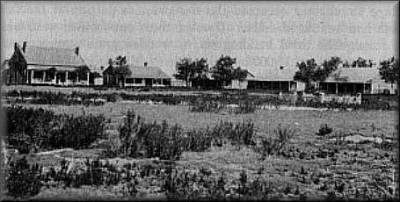Fort Wallace was built in Wallace County, Kansas to help defend settlers against Cheyenne and Sioux raids. For over a decade, Fort Wallace was one of the most important military outposts on the frontier.
 |
| Fort Wallace - 1867 |
Forts Harker, Wallace and Hays were built in the order named to guard the Smoky Hill Trail, the “short cut” to Denver which passed through the land claimed by the Cheyenne and, to a lesser extent, Arapaho and Sioux in Kansas.
Fort Wallace was first called Camp Pond Creek. It was initially established as a Butterfield Overland Despatch station on June 4, 1865. At first it was known as the Pond Creek Stage Station, and a small garrison was posted there to protect oxen-pulled freight trains and, starting in October, stagecoaches traveling this route.
Pond Creek Station was located near the western border of Kansas on Pond Creek, a tributary to the Smoky Hill. It was one and one-half miles west of present-day Wallace, Kansas. The Pond Creek Station was a rest station that provided food to travelers. Because this station saw so many Indian attacks, a temporary military camp was situated right next to it.
Due to the Indian raids, the stage line soon became insolvent and in 1866, it was sold. Although the new owner of the line, Ben Holladay, continued to use the station, the military camp moved a few miles east to the south fork of the Smoky Hill River.

Fort Wallace - 1882 - Two mess halls and other buildings
In 1866, the new post was named Fort Wallace in honor of General W.H.L. Wallace, who died at the Battle of Shiloh, Tennessee, in the Civil War. The soldiers stationed here built the fort. The buildings were constructed of native stone or wood which peaked at forty in number. Fort Wallace was the most western military post of any permanency in Kansas.
From
1865 to 1878, Fort Wallace saw the most action, and was the fort that
participated in the most confrontations with the Native tribes. Its functions
were similar to those of Forts Hays and Harker with the exception that the
latter were larger and were more often selected as headquarters for large
expeditions against the Indians. The following statement confirms the importance
of the fort:
 |
| Fort Wallace 1880-Officers' Quarters & Commanding Officer Quarters |
“It is very evident after checking up the assignments of troops and engagements between the Indians and the military in Kansas, that the small garrisons at Fort Wallace participated in more actual engagements with the Indians and were sent to the relief of more scout and escort parties than the soldiers from any other post in Kansas. Other posts were bases of supplies and regimental headquarters where large forces were mobilized for Indian campaigns. But none defended a larger territory on the western frontier of Kansas. . . .”
Garrisons at Fort Wallace were usually low during the Indian wars of 1866-'69, since troops were constantly acting as escorts for railroad surveyors and laborers, stage coaches, wagon trains, and for government officials and quartermasters trains. In addition to the constant dangerous battles, the soldiers suffered from a lack of food and a number of disease outbreaks, including cholera in 1867.

Attack on the Wagon Train by Charles M. Russell
The westernmost frontier post in Kansas was kept busy trying to protect travelers as the Cheyenne and other Native Americans, whose homeland was being invaded by white Americans, continued to attack. The troops, which never exceeded more than 350 and averaged just 75, saw more Indian encounters than any other fort, earning Fort Wallace the nickname, the “Fightin’est Fort in the West.”
The troops continued to protect the trail until it was officially decommissioned on May 31, 1882. A small detachment of soldiers was left to protect the fort for a period of time, but they too eventually were removed. Unlike other military forts that were decommissioned, the Army did not auction off the structures or supplies left behind. Because materials were so scarce in the region, settlers scavenged building materials. Sometimes they moved entire buildings from the post. Eventually, everything except the cemetery was gone.

Fort Wallace Cemetery and Monument
Nothing
remains of the fort itself except the cemetery. The city of Wallace features
the Fort Wallace Museum. The restored Pond Creek Stage Station is located to
the west.
In my current book, Mail Order Penelope, Penelope plans to travel to Pond Creek Station near Fort Wallace. An incident at another station, where she runs into some cavalry soldiers stationed at Fort Wallace, changes her mind. You may find the book description and purchase link by CLICKING HERE.
However, in my next book, also set in Kansas, Hannah's Highest Regard, Hannah is most interested in Fort Riley in the eastern part of the state. However, she corresponds with Jake who, being assigned to the Quartermaster's Department, works with the forts to the west, including Fort Wallace. This book is currently on preorder and may be purchased by CLICKING HERE.
Hannah's Highest Regard is "the rest of the story" for Hannah. You may find the first part of Hannah's story in Hannah's Handkerchief by CLICKING HERE.
Sources:
https://www.legendsofamerica.com/fort-wallace-kansas/
http://www.ftwallace.com/HFront.html
https://kshs.org/p/the-military-post-as-a-factor-in-the-frontier-defense-of-kansas/12525
Wikipedia








1 comment:
Great blog, Zina!
Post a Comment